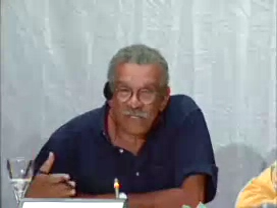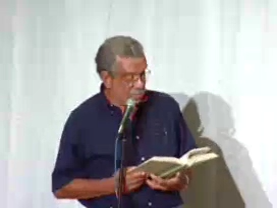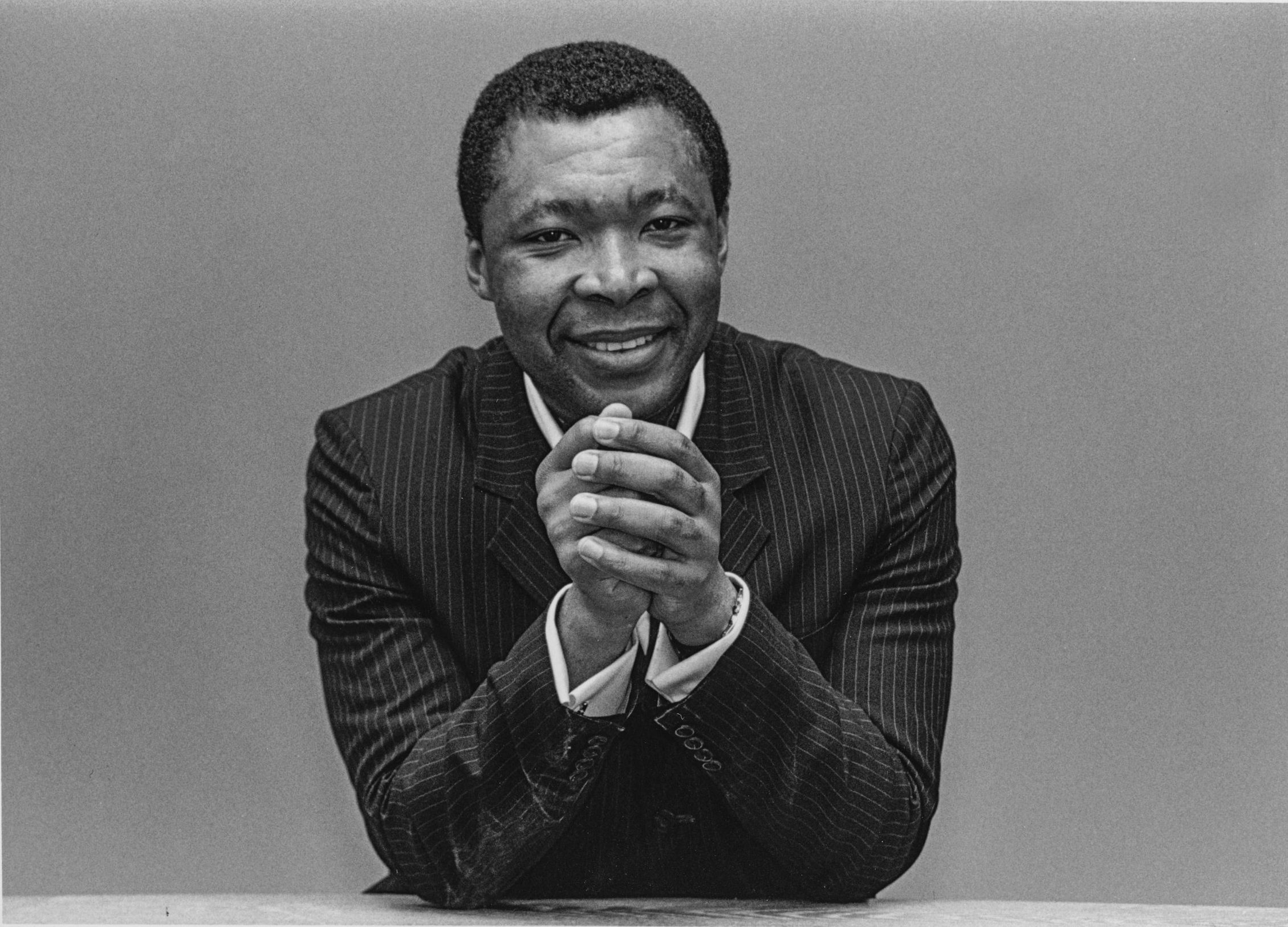The Length of the Breath
What I would like to do is to give a perhaps more real and more anguished presentation of the subject, because what we are doing here is a subject of anguish. It is a subject that has history in it, it has choice, it has class and risk and all of that. And it has a kind of defiant confidence about the future of Creole. It may be that we are confronting the death of Creole. This to me is a horrible thought, but perhaps a reality. We have to remember that nearly every modern writer, when given the choice to write in a local or parochial language or dialect, has chosen not to write in that medium. Joyce chose English, not Irish, not Gaelic, and so on. And it raised a lot of fury among people who now insist that there should be two languages in Ireland for writers. But still Irish writers continue to write in English and have the same nostalgic relationship and patriotic relationship that we have, for instance, to Creole. So I would like to clarify the process of working and what is involved for me — something very personal and perhaps negligible in terms of the polysyllabic contribution that I really cannot make to a discussion of this kind.
There are actually four languages in St. Lucia. There is English, French, French Creole, and then there is something that we never talk about, really, which is French-Creole-English. If a St. Lucian speaks French-Creole-English — for example, "the ting am teling you is dat …” — other St. Lucians may laugh at him and say, well, he is talking bad English. But in fact what he is doing is simply talking the way a Frenchman pronounces English. A practical example is this: When I was younger and watched Hollywood movies, we would be embarrassed about the way black actors like Stepin Fetchit talked — "I'm gonna do dis, 'cause I'm gonna …” etc. We did not know that in the American South everybody talks like that, including white people. The pronounciation is something shared by everyone. In a way, that may be what Chamoiseau and Glissant mean by "creolization.” In other words, the white southerner has been creolized. But now you have to do a linguistic, philological examination and ask where that accent comes from. Is it a mixture of… what? Is it some remote English thing that has migrated to the southern part of the United States and then becomes the language spoken by everyone? I don't know what that eradicates, but it certainly goes a long way toward clearing up a lot of mystification about accent, and source and class and even risk. So out of those four languages, I carry that inside me, and I think that all the other writers in different contexts of the Caribbean do as well.

© documenta archiv / Video: documenta und Museum Fridericianum Veranstaltungs-GmbH
Let me move on to something else, which may or may not be connected but that's all right. This is about an experience I had while in St. Croix. I was on the beach reading an anthology of world poetry, and at the time I was very tired of poetry. I thought: What is the point of this thing? What is this built-up stupidity about the importance of this stuff, that what it is saying is of great consequence? Books are written about it, cultures are based on it, cultures boast about it. But what does it do and what is it saying? And then I continued to read. It was an anthology of world poetry, so it contained everything. I came across a poem by Guillén, not Nicolás Guillén, but Jorge Guillén, Spanish, of course. This poem was translated, but the text was bilingual. It was also designed into little boxes or cubes of stanzas: short lines, hanging in a space, until the next stanza, and the next stanza. It was a revelation and a re-conversion and I thought: okay, this is what poetry is about. It has something to do with the infinity of the concept of design, the concept of whatever it is. And it is not a cubist thing, but I can see where cubism can come from. But what I could also see was something to do with the length of the breath. Now this may seem to be off the subject, but I can assure you it is not alien to any paper that has been presented here because this is the core of what we are talking about. So I decided: the next time I will be as honest as I can possibly be with my craft, I am not going to lie. I am not going to lie metrically. If the length of a breath of a poem is really no longer than a heartbeat, anything metrically longer than that scansion begins to be a lie, because you cannot breathe outside of that rhythm. If you do more, you will have to falsify rhythm, you will have to start with a pentameter, or an alexandrine. And therefore you have gone beyond the limit of what the breath wants you to do. I told myself, well, this ain't no big discovery. But still anything I now write, in English — and this is what I work in — I will keep to that frame. The frame began to shape itself into the same thing as the Guillén poem, which is a box or a cube. And for some reason, I wanted to do something that looked concretely, physically like those houses on the hills in the Caribbean, those houses of the poor, the shacks, the cabanes that are built on the slope of a hill, which are simply rectangular boxes or cubes made out of wood, sometimes unpainted. And I thought: if someone were breathing in patois, there is no translation for breathing. All breath is one language, all breathing is one language. There is no such thing as Spanish breathing, or American breathing. So perhaps the idea of varieties of meter is a lie. All of this was a torment, but an exciting torment. The process continued: if the poem were going to look like a piece of carpentry by a very direct and ordinary kind of creole carpenter, then the edges of the frame of the houses had to be neat, because it would be sawn to the direct edge, so I thought: you cannot write any syllable longer than the exact frame of the edge of those boxes. Everything has to fit typographically. Now there is often a discrepancy that occurs between the typewriter and print, the measurements are not always the same. So even if you lay out the design of the poem on the typewriter, there is no guarantee it will be maintained in the typesetting. I wanted the edge of the word frame to fit exactly into a cube, a physical, visual representation of a succession of stanzas on a hillside. And here is the part that is relevant to our discussion: I believe that what I was doing came out of a St. Lucian context and not out of Guillén. In other words, I said: I will not write anything beyond what I think is a St. Lucian breath. Now I just said that there is no such thing as a St. Lucian breath, but I mean that the frame would be the rhythm of an idea spoken in Creole. What I wanted was the lowest common denominator of speech, according to people who are supposed to be semiliterate or illiterate. Any elaboration beyond that meter to the semiliterate would be something they may be incapable of metrically, which is nonsensical, but no different than William Carlos Williams claiming that the meter of American breath is the trimeter. It is illogical but makes sense. So here is what I think is the process: You have someone brought up in English and Creole, writing a formal poem in English whose origin is in the reality of a St. Lucian hillside with its shacks on the slopes, and the stanzas correspond to those shacks. And the length of the poem would be a full day up to night, from sunrise to sunset, light would hit the sides of the houses in the same way that the subject of the poem would hit the sides of the stanzas, so that there would be a twenty-four-hour revolution in terms of the light on the shacks.
Why go through all that? What is the point of all the elaborate formulation of something that could just as easily be written, whatever the subject, in island prose or in a less rigid meter? Well, the rigidity of the meter was a tribute to St. Lucian conversation, to St. Lucian talk. But that tribute was not voiced in Creole. The poem was not written in Creole, but the tribute is inherent in the rhythm of what I thought was two people talking in St. Lucian, and having that measure of conversational breath. And of course the locality and the reality of the shacks and the light and the hill and the stanzas, all of that stuff I tried to put into the poem. Then I thought: Why not do the real thing — translate a stanza into patois, into French Creole? So, I took a stanza, terrified, and I said: okay, try it with rhyme. But my French Creole, my patois is not that great that I can do rhyme, which is another problem. I don't think that you can work in a poetry of any language unless you know rhyme, the rhyme of that language. The folk songs come from that. So how can you write in a language that doesn't have that knowledge of rhyme? Although I did not have it, I had French, not great French but it was there. Then I did one stanza, and what happened was the translation was not the same metaphor. It was a totally different, surprising metaphor. It was an ecstatic experience.

© documenta archiv / Video: documenta und Museum Fridericianum Veranstaltungs-GmbH
This is just to give you an idea of what it means to be a Caribbean writer using all those texts from a Spanish poet like Guillén in a completely different context, and I think that is a reality of Caribbean writing: that the origins and the sources can come from any direction. So I get very unhappy about emphatic programs about any language: what should be used, what can't be used, what is wrong. I get very suspicious of theories that have to do with nation language, because I don't like those separations that are made in terms of intellects, because these are divisions of class in a way. I think that the instinct that is there in Césaire is the same instinct that is there in the St. Lucian person walking up a hill. It is identical. The vocabulary may be different, but a poet does not feel better than everyone else. It is just that he is capable of that expression.
So I would like to finally leave one thing in mind. I have written here three words in French, for "palm": palme. (You get the little thing at the end in French, p-a-l-m-E. That is the whole point of the difference in the cultures. The little thing at the end is a big point between France and England.) Then there is palmier and palmiste. Of all those words, the one that to me most resembles a palm is palmier. Because visually it has that extra curling of the fronds in the wind that makes that turn possible in the length of the line. Palme is short, it is botanical. Palmier has the extra thing with the wind. What happens? You make a choice among those words. You have right and access to any word as a writer, any word in the world. But ultimately what matters is what you feel is right for where you are. Could one write a language in which when you came to a word that you felt was right, that if you said "the palmiers moved in the wind," you are italicizing? If you are italicizing, you are doing the wrong thing, you are translating, and to translate is to go into class. Class distinctions are made, which should not happen in language.
I will leave this open-ended and hope that I have managed to convey not the problems but the anguish that occurs in the Caribbean experience in terms of language.
Derek Walcott. The Length of the Breath, in: Okwui Enwezor, Carlos Basualdo, Ute Meta Bauer, Susanne Ghez, Sarat Maharaj, Mark Nash, Octavio Zaya (ed.): Créolite and Creolization. Documenta11_Platform3. Hatje Cantz Verlag, Ostfildern-Ruit. 2003, pp. 241-244.
